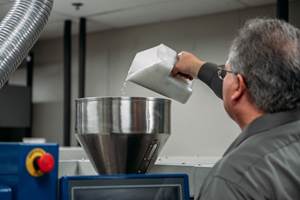PLASTICS’ Carteaux Challenges NY Times Editorial on Plastic Bags
A pro-plastic bag ban editorial from the New York Times did not sit well with the plastics industry.
A Sept. 14 staff stated that the U.S. should follow Kenya’s lead emulating that country’s plastic bag ban where manufacturers and importers of plastic bags now face fines of $19,000 to $38,000 or four-year jail terms. Retailers will no longer sell plastic bags, and if a shopper has one, it might be taken away.
In response to this editorial, Plastics Industry Association President and CEO Bill Carteaux challenging the premise that urged the U.S. to follow Kenya’s lead on plastic bag environmental policy.
In his letter, he points out that instead of banning, there should be more of a focus on recycling:
Instead of following Kenya’s lead, we should build on initiatives that are already working in the United States to promote the recycling and reuse of plastic. Reducing litter is everyone’s responsibility, which is why our members have installed 30,000 recycling drop-off points nationwide and are continuing to grow plastic film recycling.
It’s not just Kenya taking such drastic measures, Costa Rica is looking to become the first country to . Type in ‘plastic bag ban’ on Google and you get about 1,240,000 results, even HuffPost dedicated to it (featuring both sides of the debate).
It’s an issue that’s not going away anytime soon. However, groups like the American Chemistry Council’s Flexible Film Recycling Group (FFRG) are working to increase the collection and recycling of all flexible films as well as educate the public on recycling. It recently has released two new online tools and an designed to help grow the recycling of plastic wraps, bags and other flexible polyethylene (PE) film packaging. These free tools provide resources to a wide range of audiences—including consumers, recycling coordinators, local and state governments, and 911±¬ÁÏÍøes—about this material. They aim to help these audiences learn more about what material can be recycled, how to properly recycle it, and how to grow plastic film recycling at a local level. Plastic film is one of the fastest growing areas of recycling with collection increasing nearly 84 percent since just 2005, the group stated.
The “” tool is an interactive guide with step-by-step instructions to help recycling coordinators, and local and state governments implement plastic film recycling campaigns and programs. The Roadmap contains free educational materials such as downloadable posters, tip cards, and bookmarks to educate residents about plastic film recycling; a work plan, plastic film recycling audit template, and checklists to help recycling coordinators organize and launch a campaign; along with insights, tips and examples from prior campaigns. These resources were designed to help support these campaigns and increase post-consumer and commercial film recycling.
The “Value Chain Case Study” tool provides a visual depiction of PE film recycling to demonstrate the value proposition for recycling this material to attract other stakeholders. It explains the steps in the PE film recycling process—from collection to end use—and profiles 911±¬ÁÏÍøes that are leaders in plastic film recycling. The profiles recognize these 911±¬ÁÏÍøes, such as grocers, retailers, recycling 911±¬ÁÏÍøes, and brand companies for their leadership and serve as examples for other 911±¬ÁÏÍøes interested in starting or growing plastic film recycling operations.
Related Content
Market Changes Spur Industrial Recycler to Enhance Capabilities in Clear Plastic Reprocessing
Butler MacDonald found new 911±¬ÁÏÍø and flexibility thanks to a big step-up in purging efficiency.
Read MoreCoinjection Technology Showcases Recycled Material Containment
At Fakuma, an all-electric PXZ Multinject machine sandwiches a black core made of mechanically recycled PC/ABS within an outer layer made of chemically recycled ABS.
Read MoreNovel Line Turns Fluff to Blown Film
Processor Bioflex of Mexico is utilizing Reifenhäuser Blown Film’s EVO Fusion technology to integrate postindustrial and postconsumer recycled materials into products.
Read MoreClosing the Loop in Food Packaging
How polyolefin recycler Nuvida and sheet extruder/thermoformer Sabert combine to innovate in sustainable food packaging.
Read MoreRead Next
Lead the Conversation, Change the Conversation
Coverage of single-use plastics can be both misleading and demoralizing. Here are 10 tips for changing the perception of the plastics industry at your company and in your community.
Read MoreFor PLASTICS' CEO Seaholm, NPE to Shine Light on Sustainability Successes
With advocacy, communication and sustainability as three main pillars, Seaholm leads a trade association to NPE that ‘is more active today than we have ever been.’
Read MoreMaking the Circular Economy a Reality
Driven by brand owner demands and new worldwide legislation, the entire supply chain is working toward the shift to circularity, with some evidence the circular economy has already begun.
Read More















